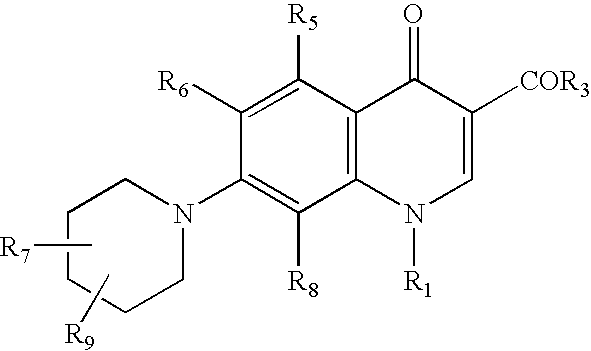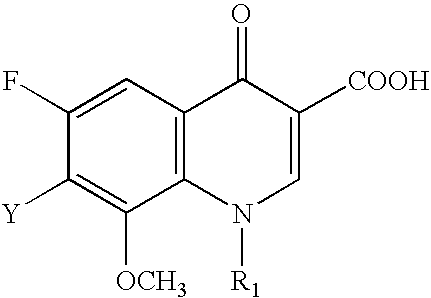Generation triple-targeting, chiral, broad-spectrum antimicrobial 7-substituted piperidino-quinolone carboxylic acid derivatives, their preparation, compositions and use as medicaments
a carboxylic acid, 7-substituted technology, applied in the direction of biocide, group 5/15 element organic compounds, drug compositions, etc., can solve the problems of insufficient understanding, unexplored full-spectrum promise of quinolones, and now a significant threat to public health in the developed world, so as to achieve increased potency and bactericidal activity
- Summary
- Abstract
- Description
- Claims
- Application Information
AI Technical Summary
Benefits of technology
Problems solved by technology
Method used
Image
Examples
preparation 1
4-Amino-3-methylpiperidine
Step-1
4-Amino-1-carbethoxy-3-methylpiperidine
Ethyl chloroformate (3.0 g, 26.7 mmol) was added to a stirred solution of 1-benzyl-3-methyl-4-piperidinone (2.0 g, 9.85 mmol) in benzene (30 ml) at ambient temperature. The obtained reaction mixture was refluxed with stirring for 6 hr and concentrated to dryness to give 1-carbethoxy-3-methyl-4-piperidone as oil. Yield 1.4 g (77%), C9H15NO3, m / z 186 (M+1).
Ammonium acetate (5 g, 64.93 mmol) was added to the stirred solution of 1-carbethoxy-3-methyl-4-piperidone (1.4 g, 7.56 mmol) in methanol (25 ml) and stirring was continued for 3 hr at ambient temperature. The resulting mixture was cooled at 0° C. and sodium cyanoborohydride (0.5 g, 7.93 mmol) was added to it. Cooling was removed after 10 min. and resulting mixture was stirred for 6 hr at ambient temperature. The reaction mixture was concentrated to dryness, triturated with water, acidified with conc. HCl (pH 3˜4) and extracted with ethyl acetate to remove impuri...
preparation 2
4-Methylamino-3-methylpiperidine
Step-1
1-Carbethoxy-4-methylamino-3-methylpiperidine
Methylamine hydrochloride (10 g, 148 mmol) was added to the stirred solution of 1-carbethoxy-3-methyl-4-piperidone (7 g, 37.83 mmol) obtained as described in Preparation 1, in methanol (50 ml) followed by 8.3 g (148 mmol) KOH. Stirring was continued for 3 hr at ambient temperature. The resulting mixture was cooled at 0° C. and sodium cyanoborohydride (3.0 g, 46.0 mmol) was added to it. Cooling was removed after 10 min. and resulting mixture was stirred for 12 hr at ambient temperature. The reaction mixture was concentrated to dryness, triturated with water, acidified with conc. HCl (pH 3˜4) and extracted with ethyl acetate to remove impurities. The aqueous layer was basified with 1 M sodium hydroxide solution (pH˜10) and extracted with ethyl acetate. Ethyl acetate extract was dried (Na2SO4) and concentrated to dryness to give 1-carbethoxy-4-methylamino-3-methylpiperidine. Yield 4.0 g (50%), C10H20N2O2...
preparation 3
4-Ethylamino-3-methylpiperidine
Step-1
1-Carbethoxy-4-ethylamino-3-methylpiperidine
Ethylamine hydrochloride (5 g, 61.34 mmol) was added to the stirred solution of 1-carbethoxy-3-methyl-4-piperidone (3.5 g, 18.9 mmol) obtained as described in Preparation 1, in methanol (30 ml) followed by 3.43 g (61.34 mmol) KOH. Stirring was continued for 3 hr at ambient temperature. The resulting mixture was cooled at 0° C. and sodium cyanoborohydride (1.4 g, 22.22 mmol) was added to it. Cooling was removed after 10 min. and resulting mixture was stirred for 16 hr at ambient temperature. The reaction mixture was concentrated to dryness, triturated with water, acidified with conc. HCl (pH 3˜4) and extracted with ethyl acetate to remove impurities. The aqueous layer was basified with 1 M sodium hydroxide solution (pH˜10) and extracted with ethyl acetate. Ethyl acetate extract was dried (Na2SO4) and, concentrated to dryness to give 1-carbethoxy-4-ethylamino-3-methylpiperidine. Yield 2.3 g (54%), C11H22N...
PUM
| Property | Measurement | Unit |
|---|---|---|
| optically active | aaaaa | aaaaa |
| compositions | aaaaa | aaaaa |
| chemical structures | aaaaa | aaaaa |
Abstract
Description
Claims
Application Information
 Login to View More
Login to View More - R&D
- Intellectual Property
- Life Sciences
- Materials
- Tech Scout
- Unparalleled Data Quality
- Higher Quality Content
- 60% Fewer Hallucinations
Browse by: Latest US Patents, China's latest patents, Technical Efficacy Thesaurus, Application Domain, Technology Topic, Popular Technical Reports.
© 2025 PatSnap. All rights reserved.Legal|Privacy policy|Modern Slavery Act Transparency Statement|Sitemap|About US| Contact US: help@patsnap.com



